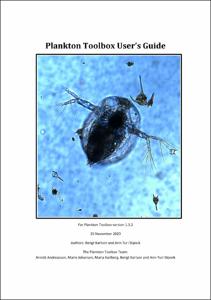| dc.contributor.author | Karlson, Bengt | |
| dc.contributor.author | Skjevik, Ann-Turi | |
| dc.date.accessioned | 2021-10-20T20:00:48Z | |
| dc.date.available | 2021-10-20T20:00:48Z | |
| dc.date.issued | 2020 | |
| dc.identifier.citation | Karlson, B. and Skjevik, A-T. (2020) Plankton Toolbox User’s Guide version 1.3.2. Gothenburg, Sweden, Swedish Meteorological and Hydrological Institute, 36pp. DOI: http://dx.doi.org/10.25607/OBP-1660 | en_US |
| dc.identifier.uri | https://repository.oceanbestpractices.org/handle/11329/1749 | |
| dc.identifier.uri | http://dx.doi.org/10.25607/OBP-1660 | |
| dc.description.abstract | Plankton form the base of the food web in most aquatic ecosystems. There is a need to estimate the biomass, abundance and the biodiversity of plankton organisms. Eutrophication, climate change, invasive species and harmful algal blooms are some of the reasons to monitor plankton. Microscope based methods are currently the standard in several monitoring programs including HELCOM-COMBINE, for the Baltic Sea, and OSPAR-JAMP, for North Eastern Atlantic Ocean covering the area between the Azores and the Arctic Ocean. Phyto- and zooplankton samples are collected using e.g. water sampling devices, hoses or nets. Data have been collected for decades and large data sets are available e.g. at international and national data centres. To work with the data in a consistent way may be difficult without the right tools.
The Plankton Toolbox is a free tool for aquatic scientists, and others, working with phyto- and zooplankton data. It is available for MacOS and Windows. Plankton Toolbox makes it relatively easy for non-programmers to work with large data sets on the diversity, abundance, biovolume and carbon content of plankton efficiently. The software is useful for working with datasets emanating from quantitative and qualitative analyses of phytoplankton and zooplankton. Phytoplankton, including harmful algae, are enumerated and identified in numerous ways; see e.g. Karlson et al. (2010). One of the most popular quantitative methods is water sampling, preservation of the sample and subsequent microscope analysis using the sedimentation chamber method (Utermöhl, 1958; Edler and Elbrächter 2010). The method produce data on the biodiversity of plankton. The cell volume of the taxa is also often included to facilitate the calculation of biomass. Plankton toolbox offers a work flow for calculating biovolume of organisms based on Olenina et al. (2006) and also carbon content based on the algorithms by Menden-Deuer and Lessard (2000). | en_US |
| dc.language.iso | en | en_US |
| dc.publisher | Swedish Meteorological and Hydrological Institute | en_US |
| dc.rights | CC0 1.0 Universal | * |
| dc.rights.uri | http://creativecommons.org/publicdomain/zero/1.0/ | * |
| dc.title | Plankton Toolbox User’s Guide: for Plankton Toolbox Version 1.3.2/1.3.3. | en_US |
| dc.type | Report | en_US |
| dc.description.status | Published | en_US |
| dc.format.pages | 36pp. | en_US |
| dc.description.refereed | Refereed | en_US |
| dc.publisher.place | Gothenburg, Sweden | en_US |
| dc.subject.parameterDiscipline | Phytoplankton | en_US |
| dc.subject.parameterDiscipline | Zooplankton | en_US |
| dc.subject.instrumentType | plankton counters | en_US |
| dc.subject.dmProcesses | Data analysis | en_US |
| dc.subject.dmProcesses | Data quality control | en_US |
| dc.description.currentstatus | Current | en_US |
| dc.description.sdg | 14.a | en_US |
| dc.description.eov | Zooplankton biomass and diversity | en_US |
| dc.description.eov | Phytoplankton biomass and diversity | en_US |
| dc.description.adoption | Multi-organisational | en_US |
| dc.description.adoption | National | en_US |
| dc.description.ebv | Community composition | en_US |
| dc.description.methodologyType | Method | en_US |
| dc.description.methodologyType | Specification of criteria | en_US |
| obps.resourceurl.publisher | https://data.smhi.se/oce/SLW/plankton_toolbox_1_3_3/Plankton_Toolbox_users_guide_1_3_3_2020-11-25.pdf | |
| obps.resourceurl.publisher | http://nordicmicroalgae.org/tools | |
 Repository of community practices in Ocean Research, Applications and Data/Information Management
Repository of community practices in Ocean Research, Applications and Data/Information Management

